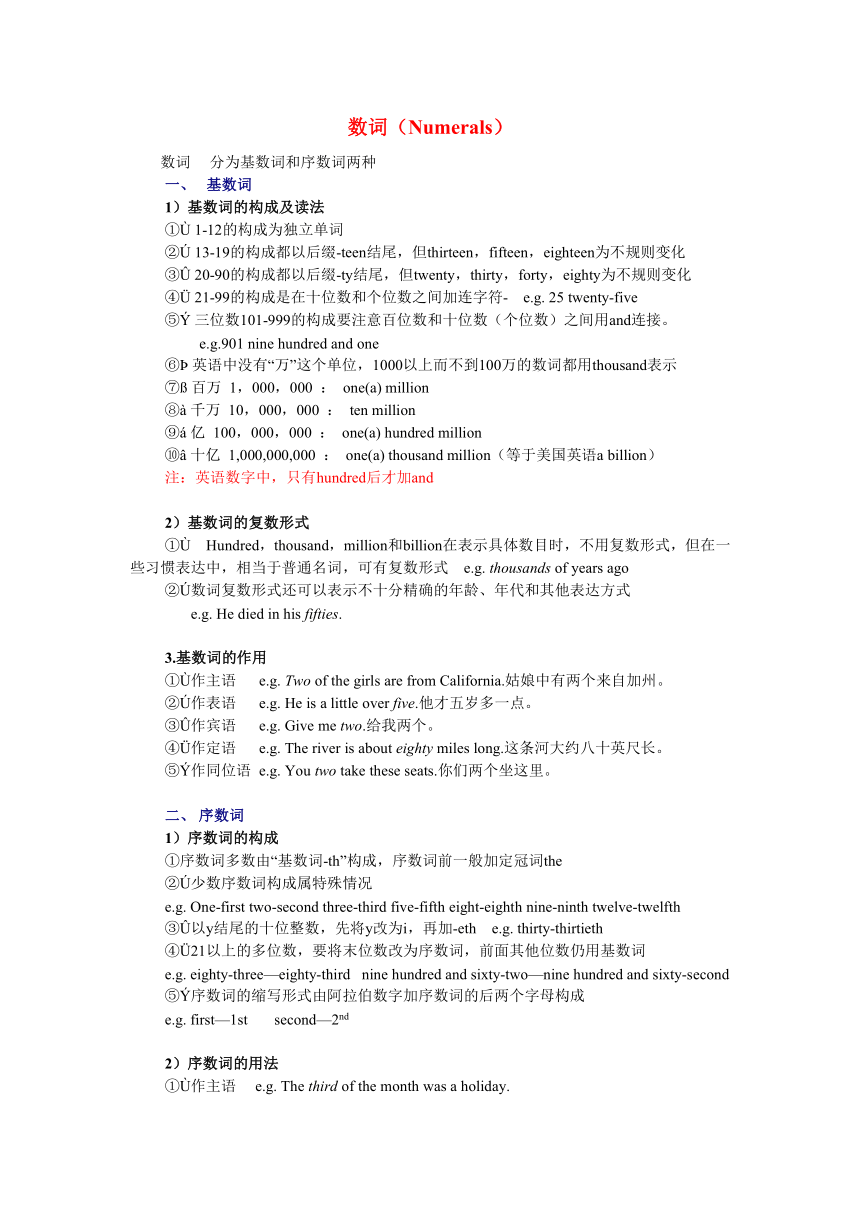中考英语 语法全套资料(新)-数词
图片预览

文档简介
数词(Numerals)
数词 分为基数词和序数词两种
一、 基数词
1)基数词的构成及读法
① 1-12的构成为独立单词
② 13-19的构成都以后缀-teen结尾,但thirteen,fifteen,eighteen为不规则变化
③ 20-90的构成都以后缀-ty结尾,但twenty,thirty,forty,eighty为不规则变化
④ 21-99的构成是在十位数和个位数之间加连字符- e.g. 25 twenty-five
⑤ 三位数101-999的构成要注意百位数和十位数(个位数)之间用and连接。
e.g.901 nine hundred and one
⑥ 英语中没有“万”这个单位,1000以上而不到100万的数词都用thousand表示
⑦ 百万 1,000,000 : one(a) million
⑧à 千万 10,000,000 : ten million
⑨á 亿 100,000,000 : one(a) hundred million
⑩ 十亿 1,000,000,000 : one(a) thousand million(等于美国英语a billion)
注:英语数字中,只有hundred后才加and
2)基数词的复数形式
① Hundred,thousand,million和billion在表示具体数目时,不用复数形式,但在一些习惯表达中,相当于普通名词,可有复数形式 e.g. thousands of years ago
② 数词复数形式还可以表示不十分精确的年龄、年代和其他表达方式
e.g. He died in his fifties.
3.基数词的作用
① 作主语 e.g. Two of the girls are from California.姑娘中有两个来自加州。
② 作表语 e.g. He is a little over five.他才五岁多一点。
③ 作宾语 e.g. Give me two.给我两个。
④ 作定语 e.g. The river is about eighty miles long.这条河大约八十英尺长。
⑤ 作同位语 e.g. You two take these seats.你们两个坐这里。
二、 序数词
1)序数词的构成
①序数词多数由“基数词-th”构成,序数词前一般加定冠词the
② 少数序数词构成属特殊情况
e.g. One-first two-second three-third five-fifth eight-eighth nine-ninth twelve-twelfth
③ 以y结尾的十位整数,先将y改为i,再加-eth e.g. thirty-thirtieth
④ 21以上的多位数,要将末位数改为序数词,前面其他位数仍用基数词
e.g. eighty-three—eighty-third nine hundred and sixty-two—nine hundred and sixty-second
⑤ 序数词的缩写形式由阿拉伯数字加序数词的后两个字母构成
e.g. first—1st second—2nd
2)序数词的用法
① 作主语 e.g. The third of the month was a holiday.
② 作表语 e.g. Who was the third
③ 作定语 e.g. We live on the fifth floor.
④ 作宾语 e.g. I was among the first to learn of this.
⑤ 作同位语 e.g. Who is that man, the first in the front row
⑥ 作状语 e.g. When did you first meet him
注:有时序数词并不指顺序,而是表示“再一,又一”的意思。此时序数词前要加不定冠词
e.g. I want to make a second try.
三、 数词的用法
1) 编号事物的表示
编号的事物常用“名词+基数词”表示,也可用“序数词+名词”表示;如果数字较大,需用“名词+基数词”表示
①住址、牌号及其他顺序号码 the ninth unit\Unit 9 Bus No.103\the No.103 bus
World WarⅡ\the second world war Room 305 76 Chang’an Street
② 汽车牌照号码、电话号码、货币数目 96178 nine six one seven eight Tel:8742589
Telephone number: eight seven four two five eight nine $5.46 five dollars forty-six cents
2) 时刻的表示法 表示时刻用基数词
①表示整点可加o’clock,口语中常省略
e.g. —Excuse me. What’s the time —It’s five (o’clock).
②表示“几点几分”有两种形式
A. 倒读法 30分以内用“分钟数+past+钟点数”,表示几点过几分。超过30分钟用“分钟数+to+下一个钟点数”,表示到几点差几分。15分钟用a quarter,30分钟用half,不用fifteen或thirty,不可在后面加o’clock。
e.g. 7:10 ten past seven 6:50 ten to seven 3:15 a quarter past three 5:30 half past five
B. 顺读法 第一个基数词表示钟点,第二个基数词表示分钟,“分钟”可用fifteen,thirty
e.g. 1:15 one fifteen 10:30 ten thirty
3) 年、月、日、时的写法和读法
① 表示日期用序数词,前面加定冠词 e.g. 3月8日 March the eighth
② 年份一般分为两部分读,先读前两位数,再读后两位数 e.g. 1949 nineteen forty-nine
③ 以上时间合在一起的写法
e.g. 1955年10月1日上午10点 10:00 a.m. October 1st, 1955
4) 分数的表示法
分数由基数词和序数词构成,基数词代表分子,序数词代表分母,除了分子为1的情况,序数词都要用复数形式。带分数中的整数用基数词表示,并用and和分数隔开。
e.g. 1\4 one-fourths 3-2\5 three and two-fifths
5) 小数、百分数的表示
① 小数的表示 e.g. 6.4 six point four 12.409 twelve point four oh nine
② 表示百分数用“基数词+percent(per cent)”形式 e.g. 50% fifty per cent
数词 分为基数词和序数词两种
一、 基数词
1)基数词的构成及读法
① 1-12的构成为独立单词
② 13-19的构成都以后缀-teen结尾,但thirteen,fifteen,eighteen为不规则变化
③ 20-90的构成都以后缀-ty结尾,但twenty,thirty,forty,eighty为不规则变化
④ 21-99的构成是在十位数和个位数之间加连字符- e.g. 25 twenty-five
⑤ 三位数101-999的构成要注意百位数和十位数(个位数)之间用and连接。
e.g.901 nine hundred and one
⑥ 英语中没有“万”这个单位,1000以上而不到100万的数词都用thousand表示
⑦ 百万 1,000,000 : one(a) million
⑧à 千万 10,000,000 : ten million
⑨á 亿 100,000,000 : one(a) hundred million
⑩ 十亿 1,000,000,000 : one(a) thousand million(等于美国英语a billion)
注:英语数字中,只有hundred后才加and
2)基数词的复数形式
① Hundred,thousand,million和billion在表示具体数目时,不用复数形式,但在一些习惯表达中,相当于普通名词,可有复数形式 e.g. thousands of years ago
② 数词复数形式还可以表示不十分精确的年龄、年代和其他表达方式
e.g. He died in his fifties.
3.基数词的作用
① 作主语 e.g. Two of the girls are from California.姑娘中有两个来自加州。
② 作表语 e.g. He is a little over five.他才五岁多一点。
③ 作宾语 e.g. Give me two.给我两个。
④ 作定语 e.g. The river is about eighty miles long.这条河大约八十英尺长。
⑤ 作同位语 e.g. You two take these seats.你们两个坐这里。
二、 序数词
1)序数词的构成
①序数词多数由“基数词-th”构成,序数词前一般加定冠词the
② 少数序数词构成属特殊情况
e.g. One-first two-second three-third five-fifth eight-eighth nine-ninth twelve-twelfth
③ 以y结尾的十位整数,先将y改为i,再加-eth e.g. thirty-thirtieth
④ 21以上的多位数,要将末位数改为序数词,前面其他位数仍用基数词
e.g. eighty-three—eighty-third nine hundred and sixty-two—nine hundred and sixty-second
⑤ 序数词的缩写形式由阿拉伯数字加序数词的后两个字母构成
e.g. first—1st second—2nd
2)序数词的用法
① 作主语 e.g. The third of the month was a holiday.
② 作表语 e.g. Who was the third
③ 作定语 e.g. We live on the fifth floor.
④ 作宾语 e.g. I was among the first to learn of this.
⑤ 作同位语 e.g. Who is that man, the first in the front row
⑥ 作状语 e.g. When did you first meet him
注:有时序数词并不指顺序,而是表示“再一,又一”的意思。此时序数词前要加不定冠词
e.g. I want to make a second try.
三、 数词的用法
1) 编号事物的表示
编号的事物常用“名词+基数词”表示,也可用“序数词+名词”表示;如果数字较大,需用“名词+基数词”表示
①住址、牌号及其他顺序号码 the ninth unit\Unit 9 Bus No.103\the No.103 bus
World WarⅡ\the second world war Room 305 76 Chang’an Street
② 汽车牌照号码、电话号码、货币数目 96178 nine six one seven eight Tel:8742589
Telephone number: eight seven four two five eight nine $5.46 five dollars forty-six cents
2) 时刻的表示法 表示时刻用基数词
①表示整点可加o’clock,口语中常省略
e.g. —Excuse me. What’s the time —It’s five (o’clock).
②表示“几点几分”有两种形式
A. 倒读法 30分以内用“分钟数+past+钟点数”,表示几点过几分。超过30分钟用“分钟数+to+下一个钟点数”,表示到几点差几分。15分钟用a quarter,30分钟用half,不用fifteen或thirty,不可在后面加o’clock。
e.g. 7:10 ten past seven 6:50 ten to seven 3:15 a quarter past three 5:30 half past five
B. 顺读法 第一个基数词表示钟点,第二个基数词表示分钟,“分钟”可用fifteen,thirty
e.g. 1:15 one fifteen 10:30 ten thirty
3) 年、月、日、时的写法和读法
① 表示日期用序数词,前面加定冠词 e.g. 3月8日 March the eighth
② 年份一般分为两部分读,先读前两位数,再读后两位数 e.g. 1949 nineteen forty-nine
③ 以上时间合在一起的写法
e.g. 1955年10月1日上午10点 10:00 a.m. October 1st, 1955
4) 分数的表示法
分数由基数词和序数词构成,基数词代表分子,序数词代表分母,除了分子为1的情况,序数词都要用复数形式。带分数中的整数用基数词表示,并用and和分数隔开。
e.g. 1\4 one-fourths 3-2\5 three and two-fifths
5) 小数、百分数的表示
① 小数的表示 e.g. 6.4 six point four 12.409 twelve point four oh nine
② 表示百分数用“基数词+percent(per cent)”形式 e.g. 50% fifty per cent
同课章节目录
- 词法
- 名词
- 动词和动词短语
- 动词语态
- 动词时态
- 助动词和情态动词
- 非谓语动词
- 冠词
- 代词
- 数词和量词
- 形容词副词及其比较等级
- 介词和介词短语
- 连词和感叹词
- 构词法
- 相似、相近词比较
- 句法
- 陈述句
- 一般疑问句和否定疑问句
- 特殊疑问句及选择疑问句
- 反意疑问句
- 存在句(There be句型)
- 宾语从句
- 定语从句
- 状语从句
- 主谓一致问题
- 简单句
- 并列句
- 复合句
- 主谓一致
- 主、表语从句
- 名词性从句
- 直接引语和间接引语
- 虚拟语气
- 感叹句
- 强调句
- 倒装句
- 祈使句
- 句子的成分
- 句子的分类
- 题型专区
- 单项选择部分
- 易错题
- 完形填空
- 阅读理解
- 词汇练习
- 听说训练
- 句型转换
- 补全对话
- 短文改错
- 翻译
- 书面表达
- 任务型阅读
- 语法填空
- 其他资料
